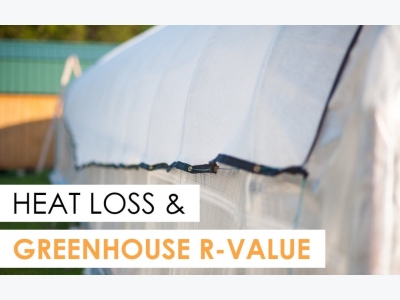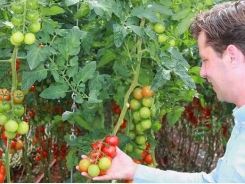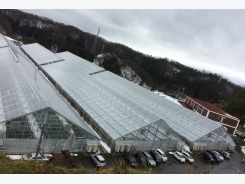How to Decipher Heat Loss and Greenhouse R-Value

Hundreds of new small farmers are entering the industry every year, and greenhouses are one of the easiest ways to get started growing your small farm. The challenge many greenhouse growers face is that greenhouses can be tough to heat and cool efficiently.
HVAC systems can get pricey, but the alternative is the often poor-fitting and inefficient self-made systems.
And inefficiency means lost money.
Luckily, efficiency is what Ceres Greenhouse Solutions does best. Ceres is focused on empowering greenhouse growers by delivering the most productive, cost-effective growing environments for farmers.
Researchers like Lindsey Schiller and Marc Plinke are there to create and match those solutions to the farmers who need them. The two recently published a book on building and outfitting solar-powered greenhouses. Today we get a peek as they explain a key metric for heating.
One of the main challenges that greenhouse farmers have to face is heating. If you live in a place that dips out of the ideal temperature range for your crops, then you’ve probably faced this issue yourself. And anyone who has begun to look into heating their greenhouse has come across the term, “R-Value”.
A greenhouse’s R-value is key to measuring the heat needs of your greenhouse and choosing materials that allow you to heat the greenhouse efficiently. Read on for an explanation of R-values, heat loss, and glazing (light-transmitting) materials that balance the two.
Psst… Looking for more answers on heat and cooling efficiency? Check out the free webinar on September 21st. All you have to do it show up and start asking.
*This text is an excerpt from the book, The Year-Round Solar Greenhouse by Lindsey Schiller and Marc Plinke. Check out the book here for more high-quality information on building solar greenhouses.
Understanding R-Values: How Much Insulation Is Enough?
The universal metric for rating insulation materials is the R-value. It measures a material’s resistance to thermal conduction, or its insulating quality. The higher the R-value, the more insulating. R-values dominate any discussion of insulation because they are a simple value that can be applied to any material. However, what is less discussed is that R-values are only part of the equation that measure the total heat loss through a wall of surface, which can be defined as:
Heat Loss = (1/R-value)(surface area)(∆T)
R-value = resistance to heat transfer of a material
∆T = the difference between the inside and outside temperatures in degrees F
Importantly, the relationship between R-values and heat loss is not linear, as shown in the figure below. That fact has major implications when choosing an insulation strategy. We say “strategy” because you naturally have choices about where and how much to insulate. The graph shows that heat loss plummets as you move from an R-1 to an R-2 but changes relatively little when increasing fro man R-20 to and R-21. Though in both cases the R-value increases by 1, the first upgrade will have a huge impact on total heat loss, the second comparatively little.

The implication is that money is much better spent adding some insulation to low-R-value surfaces like glazing, rather investing greatly in “super–insulated” walls with very high R-values. Due to this non-linear relationship, we recommend ensuring that all glazing materials have a decent R-value (at least R-2).
To further illustrate this point, the next graph compares different combinations of R-values for the glazing area (in both the roof and on the walls) and for the insulated wall area. We use a hypothetical greenhouse, and keep other variables the same, changing just the R-values of each surface.
The first scenario represents a traditional uninsulated greenhouse with polyethylene or single-pane glass glazing (R-0.83) on all sides and the roof. There is no insulated wall area.
The second assume the same structure has a double-layer of glazing (R-2) on all surfaces.
The third adds R-10 insulation on the north wall, and some on the east and west. Now the greenhouse has what we would call a 50% glazing-to-insulation ratio, about half the area is insulated with an R-10 wall and the other half with R-2 glazing.
From there, we alter the two variables slightly, changing the insulated wall area to R-40 (run #4), or changing just the glazing to R-3 (run #5). The last represents the most efficient structure, combining an R-40 wall with R-3 glazing.

The change in total heat loss demonstrated the payback of upgrading glazing materials to a decent R-value. Adding the second layer of glazing (going from R-1 to R-2) cuts heat loss by over 50%. Adding the insulated wall reduces total heat loss by another 35%. From there, the payback becomes less straightforward. Going from an R-10 to an R-40 wall only creates heat savings of 10%.
Whether this investment is worth it depends on your goals for the greenhouse, the current cost of heating, the cost of the insulation material, and your climate. To evaluate the effect for your area, we recommend performing your own quick analysis using an online heat loss calculator, such as “the Home Heat Loss Calculator” on builditsolar.com. Hand calculations are also possible but are becoming less relevant given the ease and functionality of online calculators.
We flesh this out because a common mistake we see is the devotion of lots of money and effort to creating super-insulated walls (R-40 or greater) while at the same time using very poor glazing materials. The justification is usually, “I need a think glazing for light transmission.” However, adding a second layer of glazing is usually only a 10% reduction in light. Given the enormous energy savings from that extra layer, in our opinion, the increased temperatures and performance are worth it.
*End of excerpt
Once you understand R-value, you can start comparing different greenhouse materials and insulation. Every greenhouse will have unique needs. For instance, Bright Agrotech’s greenhouses in Laramie utilize a double-layer of polyethylene combined with a boiler to compensate for the frigid winters.
Like Lindsey mentioned above, doubling up on your glazing (the light-transmitting material of the greenhouse – in our case, the polyethylene layers) usually has higher rewards in insulation than losses in light. Growers can often balance light loss other ways; for example, Bright Agrotech’s greenhouse used reflective ZipGrow Towers and conveyor cropping to utilize light more efficiently.
Related news
Tools

Phối trộn thức ăn chăn nuôi

Pha dung dịch thủy canh

Định mức cho tôm ăn

Phối trộn phân bón NPK

Xác định tỷ lệ tôm sống

Chuyển đổi đơn vị phân bón

Xác định công suất sục khí

Chuyển đổi đơn vị tôm

Tính diện tích nhà kính

Tính thể tích ao




 Wireless sensor network for agricultural communities launched
Wireless sensor network for agricultural communities launched  Modern greenhouse horticulture in Japan
Modern greenhouse horticulture in Japan